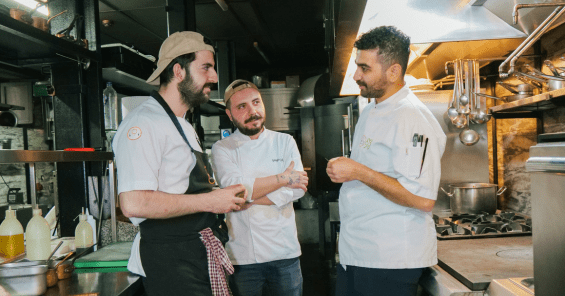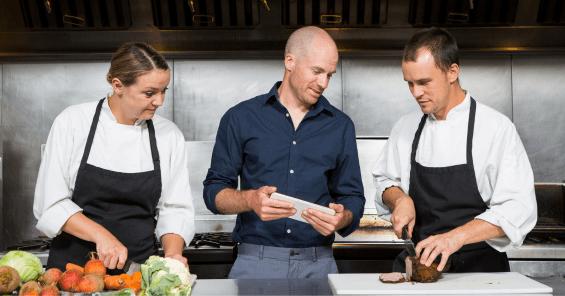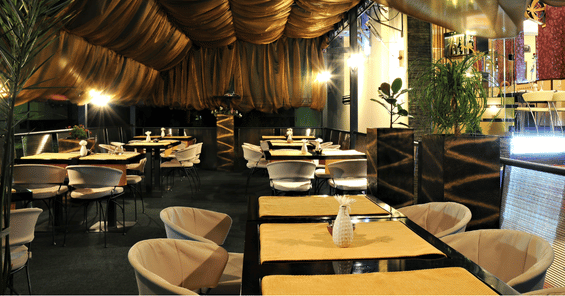
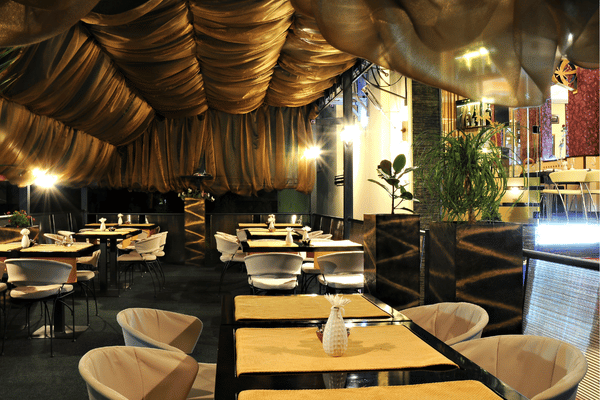
The Top 22 Reasons Why Restaurants Fail (And How You Can Fix It)
Longevity in the restaurant business is tough, but just getting a new restaurant off the ground can be even more challenging. In fact, 60% of all restaurant startups fail within the first year. What are the top reasons why most restaurants fail and how can the most common pitfalls be avoided from the get-go? Aspiring restaurateurs, take note and jot down these tips...
The restaurant industry is a difficult one to succeed in. The statistics illustrate this sobering fact—sixty percent of restaurants don't survive their first year in business, and 80 percent close within five years. Additionally, an IBISWorld report found that 67 percent of a full-service restaurant's costs go directly to purchase expenses and wages. On top of that, the average profit margin for a restaurant is only 6.2 percent. With a profit margin this slim, it's no wonder why insolvency is often, unfortunately, right around the corner. There's good news, though—researchers at Cornell University discovered that the primary reasons for restaurant failure are widely preventable. With savvy business leadership, a delicious menu, experienced staff, a great location, and stellar vision, you might have what it takes to run a successful and financially sustainable establishment people will love. In this article, we'll explore the top reasons restaurants fail and how you can overcome the challenging hurdles that come with the industry.
The Ultimate Guide to Restaurant Success: Optimizing Operations, Maximizing Profits, and Building a Loyal Customer Base
🔓 Unlock the secrets to restaurant success with actionable strategies for optimizing operations, maximizing profits, and building a loyal customer base.
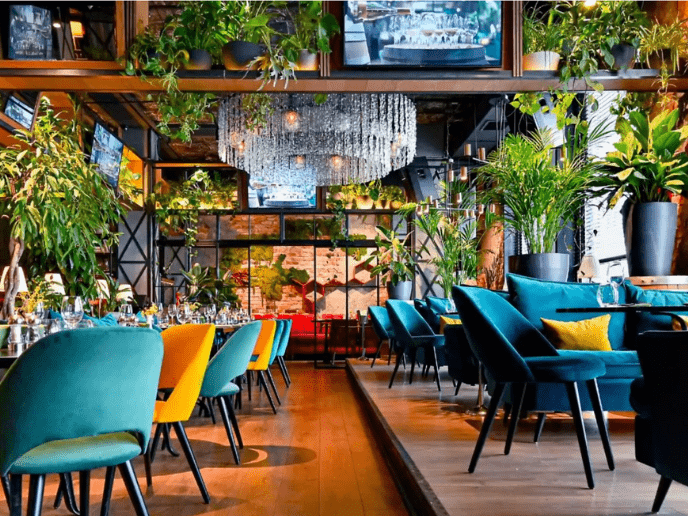
Why Do Restaurants Fail?
- Insufficient Marketing
- Inefficient Marketing
- Poor Customer Service
- Not Being Mobile-Friendly
- Bad Business Strategy
- Staffing Problems
- High Food Costs
- Poor Inventory Management
- Lack of Startup Capital
- Poor Restaurant Design and Layout
- Choosing a Poor Location
- Providing Bad Food Options
- Insufficient Marketing
- Not Knowing How to Run the Numbers
- Not Adapting to New Technology
- Not Accommodating Dietary Restrictions
- Being Too On-Trend
- High Staff Turnover
- Not Enough Repeat Patrons
- Internal Theft
- Little to No Owner Involvement
- Poor Management
1. Insufficient Marketing
One of the biggest mistakes a restaurant owner can make is not investing enough in marketing. In 2018, there were over 660,000 restaurants in the US – it's inconceivable for a restaurant to survive without marketing, given the competitive landscape. Successful restaurants often have an integrated marketing plan that gives customers different ways to discover, access, and interact with them. Most restaurants can't get by on word of mouth alone – investing in marketing is, if anything, a way to amplify it.
You don't need all of the bells and whistles to be successful, but a meaningful investment into marketing your business and getting customers in the door goes a long way for your profit margins. With such fierce competition for space in your customer's stomachs, standing out from the crowd is crucial. Resting on your laurels, however, can be a death sentence.
Here are some tips to get your marketing program off the ground.
How To Succeed:
- Update your website
According to a report by Facebook, mobile ordering will generate $38 billion in 2020. Combine that with the fact that 82 percent of millennials look online to plan their next meal, and it's clear that having a discoverable presence online is crucial to getting customers in the door.
- Work on your social media clout
Approximately 77 percent of the US used some form of social media in 2019. They're using Pinterest to find recipes, Instagram for #foodporn, and Facebook to find coupons, deals, and events. Social media is an excellent way to generate local business, whether you try your hand at food photography or you're giving out coupons on Facebook.
- Build a community
With so much competition for screen time and stomach space, building a community around your restaurant can help drive customer acquisition and retention. You don't have to go so far as to make commercials that say "when you're here, you're family," but create a hashtag for your customers to help create a welcoming environment people want to participate in and return to.
- Focus on influencer marketing
Influencer marketing is all the rage these days—they're a cost-effective way to create word-of-mouth buzz at scale. However, authenticity is the name of the game in the world of influencers, so when you contact social media mavens, make sure they're local, authentic, and can offer a genuine review of your food. Some good plating and lighting won't hurt either.
2. Inefficient Marketing
Your marketing may check all the boxes but may not be good enough to convince new customers to come through your doors. Having a website isn't enough: it needs to work and work well. Having a brand, logo, or flyers isn't enough: they have to look good, read well, and effectively communicate your restaurant's value.
How To Succeed:
Start setting goals, testing different messages, and planning campaigns around events, debuts, or new menu items. Especially in the post-COVID world, wherein many consumers stay at home and cook their meals, making your food look as appealing as it tastes is critical. Your restaurant doesn't have to be quite instagrammable, but your marketing should look good.
Inefficient marketing can often lead to people passing over your business when consumers decide where they want to eat, especially in a mobile-first world. Standing out from the crowd, especially in a fiercely competitive market, takes going above and beyond the competition.
3. Poor Customer Service
There's hardly an excuse for poor customer service in the age of social media and google reviews. Some restaurants have even failed because a rude server, an angry owner, or a spiteful chef messed with the wrong Yelp power user. That's not to say that customers have all the power now or that you're not entitled to run your restaurant as you see fit, but consistently poor customer service will destroy your business.
Consistently poor reviews are often revelatory of deeper problems with your restaurant – and your customers will notice. Here are some examples of bad customer service:
- Late orders
- Wrong orders
- Inability to accept criticism
- Rude staff or management
- Long wait times
- No greeters
- Hostile environment
How To Succeed:
Anything that negatively contributes to the customer experience is a knock against your restaurant, and in this business, first impressions count. A poor customer experience can find its way to review aggregate sites before you can even close your doors for the night. Ensure you're providing the best customer service possible and train your staff to serve up dishes with a smile.
When a user leaves a negative review, try to respond in an amicable and understanding manner. If the review is reasonable, you may consider inviting them back and offering something on the house to incentivize them to revise their review.
4. Not Being Mobile-Friendly
In the world of UberEats, Seamless, and Yelp, it's easier than ever before for a hungry customer to get restaurant-quality food with the push of a button. Mobile ordering and delivery have helped even the playing field between restaurants while simultaneously amplifying the competition. Anyone can type "Indian Food" into their favorite delivery site and find every possible restaurant in their area to deliver.
You don't necessarily have to adopt a mobile-first approach (although the COVID-19 pandemic made it necessary for many of us). Still, you should be available where your potential customers are looking.
How To Succeed:
Being available for mobile ordering and delivery is a no-brainer to win new customers. At the same time, being inaccessible by google searches, Yelp, or delivery apps can unnecessarily hinder your business. Considering over 60 percent of Americans order delivery or takeout every week, and mobile ordering is growing over 300 percent faster than dine-in, getting online is more important than ever before.
5. Bad Business Strategy
Let's face it: not everyone can run a business. Some lack the business acumen, others lack the patience, and some just don't have the luck to make it. Running a successful restaurant requires good-tasting food, a pleasant atmosphere, and perhaps above all else, a clever business strategy.
We can break down poor strategy into three (non-exhaustive) categories:
Poorly Designed Menu
Making sensible adjustments to your menu, offering seasonal items, or manager's specials are intelligent ways to take advantage of trends, provide exclusive meals, and differentiate your restaurant. However, there are plenty of ways an overzealous approach to your menu can doom your restaurant. Having too many items, or even too few items, can unnecessarily waste money and time. If your restaurant is known for a particular style of cuisine, pivoting to another unrelated style might not be the most brilliant move without a strategy behind it. Jumping on the latest food trends may seem like a good idea, but devoting unnecessary resources to it can quickly put you in the red.
Poor Staffing
Overpaying or underpaying your staff can waste resources or lead to negative customer experiences. Overpaying staff can lead to high payroll costs that can needlessly harm your bottom line. Underpaying them can lead to a "brain drain" of good talent while limiting your access to friendly or competent employees. We'll talk more about the consequences of this from different angles later, but strategically, the way you treat your staff speaks volumes about your business.
Poor Financials
Lavish overspending or needless belt-tightening are two sides of the same coin – either is reflective of an ineffective financial strategy. Investing in your restaurant is an excellent idea if it will yield results, but you can be strategic about what money goes where. No, maybe your family Italian restaurant doesn't need a gold toilet, but fluorescent lighting might help the ambiance.
How To Succeed:
You must make strategic menu decisions with appropriate financial, market, and operational research. In other words, if you're known for sushi, maybe you don't need to offer Gyros too.
6. Staffing Problems
Your staff plays a huge role in your restaurant's health and long-term profitability. Efficient waitstaff, friendly servers, and competent management can help overcome other areas your restaurant lacks. On the flipside, rude or untrustworthy staff can bleed your restaurant dry. They can drive away customers, leech out your inventory, or even drink away all the alcohol at your bar.
How To Succeed:
Hiring staff requires as much care as every other aspect of your business. Believe it or not, hard workers are not hard to come by – but fair wages often are. Consider how your wages, tips, and working environment affect your staff when recruiting or evaluating your team, and identify areas that need improvement. And, of course, don't be afraid to let rude or unruly staff members go if they're seriously affecting your bottom line.
7. High Food Costs
Inordinately high food costs can eat away at your restaurant's profitability and long-term financial health. And if you're not consistently tracking and calculating your food costs, you could very well be hemorrhaging money needlessly.
Food costs, defined as the price your restaurant pays for food, make up a large portion of your restaurant's bottom line. Spending too much on ingredients for menu items that are inappropriately priced or rarely ordered can bleed your bank account dry.
How To Succeed:
Keeping tabs on your food costs is critical to your restaurant's survival. It helps you make educated menu and pricing decisions, identify where to get better deals on supplies, and even helps you understand the impact food waste has on your bottom line.
Failing restaurants often do not have enough of a handle on this: whether their prep cooks are wasting ingredients, their menu items are priced too high or too low relative to their food costs, or they simply aren't getting good enough deals on their inventory, it all adds up in the end.
8. Poor Inventory Management
Poor inventory management can often be the root cause of excessively high food costs. Wasting food, letting it expire, or not ordering enough ingredients can lead to long-term difficulties in your restaurant's operations.
Either way, restaurants that don't keep tabs on their inventory can quickly lose control of their finances. It's okay to run out of the prime rib on Sundays, but it's not okay to run out of staples over a long period. In the same vein, throwing out rotting or expired ingredients because of neglect or over-ordering is an unnecessary drain on your finances.
How To Succeed:
Any successful and efficient restaurant operation runs clean books, whether that means hiring an accountant to keep tabs on inflows and outflows or leveraging a sophisticated point of sale system to automate your inventory management.
9. Lack of Startup Capital
Opening a restaurant can require hundreds of thousands of dollars, depending on the type of restaurant and the location. Covering payroll, food costs, rent, decoration, vendors, and equipment is crucial to your operations, but be careful not to overspend before your business can start turning a profit.
At the same time, a lack of startup capital before your restaurant can get off the ground can spell doom before you even have a chance to open the doors. If you can't cover payroll or have enough food to serve a consistent menu, there's hardly a point in trying.
How To Succeed:
Be sure your financials are in order, and stick to the plan as best you can before over-committing your limited resources.
10. Poor Restaurant Design and Layout
Your restaurant's layout and design are core to the customer experience. It's not just about how pretty it looks: it's how approachable, accessible, and enjoyable the atmosphere is. Your restaurant may have a particular theme, but ensure it's one that your customers are interested in experiencing. Moody dance floor at a sushi bar might be a hit for your older clientele, but a gothic Transylvanian-themed steakhouse might not.
How To Succeed:
Cultivating an atmosphere is a function of the ambiance, the music, and the interior design of your restaurant. This atmosphere should match your restaurant's brand identity: it might be jarring if an American restaurant sports a dojo theme. This plays into your restaurant's approachability, or how it feels for a customer to walk in and sit down for a meal.
Some high-end restaurants opt for architecture and design that feels intimidating, like tall marble columns and Victorian accouterments, to contribute to the atmosphere of fine dining; in the same way, some diners will opt for comfy plush seats and bar stools. What matters is that the atmosphere and aesthetic matches the dining experience. Failing to do that can quickly turn customers away and the end of your business.
11. Choosing a Poor Location
In many ways, location is one of the essential facets of your restaurant's survivability. It would be best to think through all the possible customer experiences of your potential site before the opening. Ask yourself these questions before getting started:
- Is it easily accessible by car or public transportation?
- Is there parking nearby? Is that parking free, or is safe street parking readily available?
- Is your location friendly to foot traffic, like on the main street or in front of a busy sidewalk?
- Are there other restaurants nearby? Can your restaurant compete?
- Is your restaurant easily visible or accessible?
- Does your restaurant have a wheelchair or handicapped accommodations?
How To Succeed:
Your answers to those questions will significantly impact your customer experience. A restaurant that is difficult to reach, or is buried behind other competing restaurants, can be easily forgotten or ignored by passersby. Pair a lousy location with bad marketing, and your restaurant is on a one-way train to failure town.
12. Providing Bad Food Options
The whole point of opening a restaurant is to serve good food that people are willing to pay for. You'd be surprised, however, how restaurant owners often overlook food quality. Bad, mediocre, or just plain old food can quickly put off your customers and ensure they never return. If other aspects of your restaurant are good, like the location, the price, or the ambiance, they may be able to excuse it. But bad food, in the end, will eat your restaurant from the inside out.
How To Succeed:
Invest your resources into recipe development, taste testing, and chef scouting to ensure you can produce a consistent product for your customers, regardless of your budget or style. Be sure to listen to your chefs and solicit their feedback on menu improvement often. In the same way, listen to customer’s opinions as well to gauge what changes they’d like to see.
You can also be creative with marketing your underrated items by using appetizing titles, descriptors, and photos. Consider offering them as specials to create some buzz, too.
13. Not Having Enough Restaurant Industry Experience
While you may be a great chef, that doesn't directly translate into being a successful restaurant owner. Or, say you have lots of business experience in a different industry and want to try something new—again, not a great sign you'll be a great restauranteur. It takes years of work and dedication to learn the ins and outs of the industry. Failing to understand the intricacies of a restaurant's financials and operations will likely cause you to fail before opening day. It's not just about serving up great food and atmosphere—it's about creating a business strategy that ensures your revenue consistently covers your labor, overhead costs, and costs of goods sold (COGS).
How To Succeed:
Gain skills in business management, marketing, financial management, and more through on-the-job training, formal education, or both—and know-how to hire smart people to complete the tasks you're not as good at. Spend time working in a restaurant and get deep in the trenches behind every role you'll need to understand as a future restaurateur.
14. Not Knowing How To Run The Numbers
Another reason a restaurant may fail is that its leaders don't understand how to interpret the business' critical statistics. Restaurant owners may misread profit and loss statements or payroll data and overspend, cutting deep into profit margins.
How to Succeed:
Analyze the reports from your point-of-sale (POS) and inventory management system regularly. Make business decisions based on complex data, and never resort to guessing. Keep track of your financial goals to ensure you're hitting them. And if numbers aren't your strong suit, no sweat—partner with an expert to help you out. Making smart business moves and staying on top of financial reports separates passionate restaurateurs from successful ones.
15. Not Adapting to New Technology
A new wave of ultra-tech-savvy customers means restaurants that don't adapt to current technology are doomed to fail. Not getting online means getting left behind.
You should already have a website in place, but testing it for user experience is highly important. Is the menu easy to find and read? Are the social media channels up-to-date with fresh content? There are also streamlined tech solutions for every aspect of running your restaurant operations, like comprehensive restaurant management software.
How to Succeed:
Implement tech solutions like a POS that can provide you with essential business data. Partner with delivery companies (or start one of your own) to reach more customers. Establish a loyalty program to turn first-time customers into repeat diners. Ensure your restaurant’s mobile ordering experience is enjoyable and seamless, implement QR menus, and keep Google My Business information up-to-date.
16. Not Accommodating Dietary Restrictions
Now more than ever, customers are looking for restaurants that can accommodate specific dietary restrictions. Whether they're looking for gluten-free, dairy-free, vegetarian, or vegan options, the modern diner requires a more tailored menu.
How to Succeed:
Update your menu. While you don't need to turn your barbecue restaurant into a vegan's paradise, your restaurant can become more accessible to customers with dietary restrictions by including items labeled accordingly.
17. Being Too On-Trend
Foodie trends like cronuts, rainbow bagels, and matcha come and go. Restauranteurs may feel inclined to hop on the bandwagon and ride their wave of popularity, which leads to the oversaturation of these concepts. More competition requires more edge to stand out to survive.
How to Succeed:
Do your research to ensure your market isn't oversaturated with similar concepts. If you decide to go all-in on a trendy concept restaurant, be ready to outdo your competition by getting creative with marketing and hiring the best management possible. Check out these 17 unique restaurant ideas for 2021.
18. High Staff Turnover
The restaurant staff turnover rate is a staggering 70%, so it's not surprising that restaurateurs cite hiring as one of the main challenges of running a restaurant. It's tough to find and retain experienced restaurant staff, especially when wages are often low, which leads candidates to view their role as a temporary job.
How to Succeed:
Once you find your dream team, sweeten their deal at your restaurant by increasing wages and providing healthcare and professional development opportunities such as management training and promotions. Invest in your staff so they'll see a prosperous future at your restaurant.
19. Not Enough Repeat Patrons
Repeat customers are essential for a restaurant to succeed long-term. A loyal fan base can keep business running while you attract first-timers. The data speaks for itself—according to Bain & Company, growing your repeat business by as little as 5% can increase sales by up to 75%.
How to Succeed:
While consistent service and delicious food are essential to gain repeat diners, incentives and a loyalty program can take it one step further.
Loyalty programs can incentivize repeat visits because they influence diners to come back and make more purchases in order to earn more rewards. If you have a POS system like Square or Toast, you can personalize offers according to a customer's profile. For example, you can create an automated campaign where a customer will receive a special promotion by email on their birthday.
20. Internal Theft
On-counter and inventory theft are a huge reason restaurants fail because restaurant owners often don't even realize it's happening until it's too late. This type of theft can bleed a restaurant's revenue dry and add to the restaurant's food costs. So, the restaurateur suffers the same loss two times over—once when the staff member steals, and next when the restaurateur has to cover up for the loss from the business' profits.
How to Succeed:
Implement a sophisticated POS with robust inventory management and an anti-theft feature to track all business transactions at all times. Assign specific roles and permissions to each staff member to further keep a check on thefts. Check out an example of how Toro Loco Sports Bar combats theft and COVID with MarketMan here.
21. Little to No Owner Involvement
It's no secret that the restaurant owner's involvement can make or break a restaurant. Investing your money isn't enough, and relying solely on restaurant management can often turn out to be fatal. Good owners have the most to lose, so they should be first-in and last-out, always finding new ways to build the business and extend profit margins.
How to Succeed:
Owning a restaurant requires vigilant oversight to ensure other members of upper management do not cause significant harm to the restaurant. Restaurant owners don’t have to be involved in every single aspect of daily affairs, but they do need to be present and delegate tasks to key decision-makers. Schedule regular meetings with management and staff to stay in touch with what’s going on with your restaurant.
22. Poor Management
You hire someone you think will be an excellent kitchen manager, bar manager, or general manager, and they turn out to be, well, not excellent. The situation can turn dire when a few months down the road, they might mismanage the restaurant, drive away staff, steal food or money, and more.
How to Succeed:
It's essential to be highly diligent and careful when hiring management positions. Check references, and even ask for referrals if you're unhappy with candidates. Once you make a hire, check in regularly to ensure they're working at their highest potential. Read some tips on reducing risk and encouraging loyalty in your restaurant workforce here.
Putting it All Together
Operating a restaurant is no easy task. There are so many aspects that determine your customer's experience that just focusing on high-quality food isn't enough to ensure your success. At the same time, pouring too much energy and money into the ambiance, atmosphere, or even your staff can detract from other areas.
Marketman's intuitive inventory management system can help you analyze food costs and menu prices on the fly, allowing you to quickly pivot your spending on ingredients, menu items, and more before they get out of hand. It's one of many tools you can use to keep tabs on your restaurant's health and ensure you're not one of the thousands of restaurants forced to close every year for the mistakes we listed above.
Want to learn more about running a profitable, successful restaurant? Check out our e-book: 6 Laws of a Resilient Restaurant.

Ready to cut food costs, streamline inventory management, and simplify your restaurant's back-of-house processes? MarketMan offers advanced restaurant management software that automates daily tasks, eliminates inefficiencies, and provides strategic insights for your business. Take charge of your restaurant's success with MarketMan. Book a demo now to unlock your restaurant's full potential!
Author
Contributors
If you have any questions or need help, feel free to reach out
Don't miss out on maximizing your restaurant's profits! Calculate your ROI with MarketMan
Join over 18,000 restaurants and get the hottest restaurant tips delivered to your inbox
You may also be interested in
Ready to get started?
Talk to a restaurant expert today and learn how MarketMan can help your business



